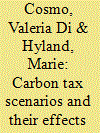|
|
|
Sort Order |
|
|
|
Items / Page
|
|
|
|
|
|
|
| Srl | Item |
| 1 |
ID:
125428


|
|
|
|
|
| Publication |
2013.
|
| Summary/Abstract |
In this paper we use annual time series data from 1960 to 2008 to estimate the long run price and income elasticities underlying energy demand in Ireland. The Irish economy is divided into five sectors: residential, industrial, commercial, agricultural and transport, and separate energy demand equations are estimated for all sectors. Energy demand is broken down by fuel type, and price and income elasticities are estimated for the primary fuels in the Irish fuel mix. Using the estimated price and income elasticities we forecast Irish sectoral energy demand out to 2025. The share of electricity in the Irish fuel mix is predicted to grow over time, as the share of carbon intensive fuels such as coal, oil and peat, falls. The share of electricity in total energy demand grows most in the industrial and commercial sectors, while oil remains an important fuel in the residential and transport sectors.
Having estimated the baseline forecasts, two different carbon tax scenarios are imposed and the impact of these scenarios on energy demand, carbon dioxide emissions, and government revenue is assessed. If it is assumed that the level of the carbon tax will track the futures price of carbon under the EU-ETS, the carbon tax will rise from €21.50 per tonne CO2 in 2012 (the first year forecasted) to €41 in 2025. Results show that under this scenario total emissions would be reduced by approximately 861,000 tonnes of CO2 in 2025 relative to a zero carbon tax scenario, and that such a tax would generate €1.1 billion in revenue in the same year. We also examine a high tax scenario under which emissions reductions and revenue generated will be greater.
Finally, in order to assess the macroeconomic effects of a carbon tax, the carbon tax scenarios were run in HERMES, the ESRI's medium-term macroeconomic model. The results from HERMES show that, a carbon tax of €41 per tonne CO2 would lead to a 0.21% contraction in GDP, and a 0.08% reduction in employment. A higher carbon tax would lead to greater contractions in output.
|
|
|
|
|
|
|
|
|
|
|
|
|
|
|
|
|
|
|
|
|